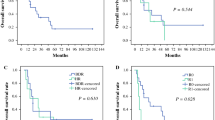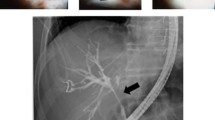Abstract
Background
Single preoperative biliary drainage for malignant perihilar biliary stricture occasionally fails to control jaundice and cholangitis. Multiple biliary drainage is required in such cases, but their clinical background is unclear. We determined the clinical characteristics associated with the requirement for multiple biliary drainage.
Methods
The consecutive 122 patients with malignant perihilar biliary stricture were enrolled in a single-center retrospective study. Preoperative biliary drainage was initially performed on the future remnant hepatic lobe. Additional drainage was performed if jaundice failed to improve or cholangitis developed in undrained hepatic lobes. Detailed clinical characteristics and the number of preoperative biliary drainage procedures required before operation were analyzed.
Results
Thirty-one patients (25.4 %) initially underwent multiple biliary drainage. However, 69 (56.7 %) required multiple biliary drainage by the time of the operation. In the univariate analysis, the initial serum bilirubin level, cholangitis, percutaneous portal vein embolization, history of inserted endoscopic biliary stenting, length of preoperative period, operative procedure, and Bismuth classification were significant factors. In the multivariate analysis using these factors, Bismuth classification was independently associated with the requirement for multiple biliary drainage. The number of patients who required multiple biliary drainage was higher in those with Bismuth-II (91.9 %), Bismuth-IIIa (65.7 %), and Bismuth-IV (92.9 %) than in those with Bismuth-I (22.2 %) and Bismuth-IIIb (18.2 %).
Conclusions
Patients with Bismuth-II, Bismuth-IIIa, and Bismuth-IV are at higher risk for multiple biliary drainage. A strategy based on the Bismuth classification for performing preoperative biliary drainage is important for patients with malignant perihilar biliary stricture.




Similar content being viewed by others
Abbreviations
- BD:
-
Biliary drainage
- B-classification:
-
Bismuth-classification
- EBS:
-
Endoscopic biliary stenting
- ENBD:
-
Endoscopic naso-biliary drainage
- ERCP:
-
Endoscopic retrograde cholangiopancreatography
- MBD:
-
Multiple biliary drainage
- NACRT:
-
Neo-adjuvant chemo-radiation therapy
- PTBD:
-
Percutaneous transhepatic biliary drainage
- PTPE:
-
Percutaneous portal vein embolization
- SBD:
-
Single biliary drainage
References
Nagino M, Ebata T, Yokoyama Y, Igami T, Sugawara G, Takahashi Y, Nimura Y (2013) Evolution of surgical treatment for perihilar cholangiocarcinoma: a single-center 34-year review of 574 consecutive resections. Ann Surg 258:129–140
Sano T, Shimada K, Sakamoto Y, Yamamoto J, Yamasaki S, Kosuge T (2006) One hundred two consecutive hepatobiliary resections for perihilar cholangiocarcinoma with zero mortality. Ann Surg 244:240–247
Saxena A, Chua TC, Chu FC, Morris DL (2011) Improved outcomes after aggressive surgical resection of hilar cholangiocarcinoma: a critical analysis of recurrence and survival. Am J Surg 202:310–320
Nimura Y, Kamiya J, Kondo S, Nagino M, Uesaka K, Oda K, Sano T, Yamamoto H, Hayakawa N (2000) Aggressive preoperative management and extended surgery for hilar cholangiocarcinoma: Nagoya experience. J Hepatobiliary Pancreat Surg 7:155–162
Natsume S, Ebata T, Yokoyama Y, Igami T, Sugawara G, Shimoyama Y, Nagino M (2012) Clinical significance of left trisectionectomy for perihilar cholangiocarcinoma: an appraisal and comparison with left hepatectomy. Ann Surg 255:754–762
Nagino M, Takada T, Miyazaki M, Miyakawa S, Tsukada K, Kondo S, Furuse J, Saito H, Tsuyuguchi T, Yoshikawa T, Ohta T, Kimura F, Ohta T, Yoshitomi H, Nozawa S, Yoshida M, Wada K, Amano H, Miura F (2008) Preoperative biliary drainage for biliary tract and ampullary carcinomas. J Hepatobiliary Pancreat Surg 15:25–30
Nuzzo G, Giuliante F, Ardito F, Giovannini I, Aldrighetti L, Belli G, Bresadola F, Calise F, Dalla Valle R, D’Amico DF, Gennari L, Giulini SM, Guglielmi A, Jovine E, Pellicci R, Pernthaler H, Pinna AD, Puleo S, Torzilli G, Capussotti L, Cillo U, Ercolani G, Ferrucci M, Mastrangelo L, Portolani N, Pulitano C, Ribero D, Ruzzenente A, Scuderi V, Federico B (2012) Improvement in perioperative and long-term outcome after surgical treatment of hilar cholangiocarcinoma: results of an Italian multicenter analysis of 440 patients. Arch Surg 147:26–34
Sugawara G, Nagino M, Nishio H, Ebata T, Takagi K, Asahara T, Nomoto K, Nimura Y (2006) Perioperative synbiotic treatment to prevent postoperative infectious complications in biliary cancer surgery: a randomized controlled trial. Ann Surg 244:706–714
Kamiya S, Nagino M, Kanazawa H, Komatsu S, Mayumi T, Takagi K, Asahara T, Nomoto K, Tanaka R, Nimura Y (2004) The value of bile replacement during external biliary drainage: an analysis of intestinal permeability, integrity, and microflora. Ann Surg 239:510–517
Nimura Y (2008) Preoperative biliary drainage before resection for cholangiocarcinoma (Pro). HPB (Oxford) 10:130–133
Kawashima H, Itoh A, Ohno E, Itoh Y, Ebata T, Nagino M, Goto H, Hirooka Y (2013) Preoperative endoscopic nasobiliary drainage in 164 consecutive patients with suspected perihilar cholangiocarcinoma: a retrospective study of efficacy and risk factors related to complications. Ann Surg 257:121–127
Kawakami H, Kuwatani M, Onodera M, Haba S, Eto K, Ehira N, Yamato H, Kudo T, Tanaka E, Hirano S, Kondo S, Asaka M (2011) Endoscopic nasobiliary drainage is the most suitable preoperative biliary drainage method in the management of patients with hilar cholangiocarcinoma. J Gastroenterol 46:242–248
Brandes JW, Scheffer B, Lorenz-Meyer H, Korst HA, Littmann KP (1981) ERCP: complications and prophylaxis a controlled study. Endoscopy 13:27–30
Cotton PB, Lehman G, Vennes J, Geenen JE, Russell RC, Meyers WC, Liguory C, Nickl N (1991) Endoscopic sphincterotomy complications and their management: an attempt at consensus. Gastrointest Endosc 37:383–393
Bismuth H, Castaing D, Traynor O (1988) Resection or palliation: priority of surgery in the treatment of hilar cancer. World J Surg 12:39–47
Nagino M, Kamiya J, Nishio H, Ebata T, Arai T, Nimura Y (2006) Two hundred forty consecutive portal vein embolizations before extended hepatectomy for biliary cancer: surgical outcome and long-term follow-up. Ann Surg 243:364–372
Abulkhir A, Limongelli P, Healey AJ, Damrah O, Tait P, Jackson J, Habib N, Jiao LR (2008) Preoperative portal vein embolization for major liver resection: a meta-analysis. Ann Surg 247:49–57
Iida H, Aihara T, Ikuta S, Yoshie H, Yamanaka N (2012) Comparison of percutaneous transhepatic portal vein embolization and unilateral portal vein ligation. World J Gastroenterol 18:2371–2376
Kubo S, Shiomi S, Tanaka H, Shuto T, Takemura S, Mikami S, Uenishi T, Nishino Y, Hirohashi K, Kawamura E, Kinoshita H (2002) Evaluation of the effect of portal vein embolization on liver function by (99 m)tc-galactosyl human serum albumin scintigraphy. J Surg Res 107:113–118
Imamura H, Shimada R, Kubota M, Matsuyama Y, Nakayama A, Miyagawa S, Makuuchi M, Kawasaki S (1999) Preoperative portal vein embolization: an audit of 84 patients. Hepatology 29:1099–1105
Makuuchi M, Thai BL, Takayasu K, Takayama T, Kosuge T, Gunven P, Yamazaki S, Hasegawa H, Ozaki H (1990) Preoperative portal embolization to increase safety of major hepatectomy for hilar bile duct carcinoma: a preliminary report. Surgery 107:521–527
Rea DJ, Heimbach JK, Rosen CB, Haddock MG, Alberts SR, Kremers WK, Gores GJ, Nagorney DM (2005) Liver transplantation with neoadjuvant chemoradiation is more effective than resection for hilar cholangiocarcinoma. Ann Surg 242:451–458 discussion 458–461
Vienne A, Hobeika E, Gouya H, Lapidus N, Fritsch J, Choury AD, Chryssostalis A, Gaudric M, Pelletier G, Buffet C, Chaussade S, Prat F (2010) Prediction of drainage effectiveness during endoscopic stenting of malignant hilar strictures: the role of liver volume assessment. Gastrointest Endosc 72:728–735
Kennedy TJ, Yopp A, Qin Y, Zhao B, Guo P, Liu F, Schwartz LH, Allen P, D’Angelica M, Fong Y, DeMatteo RP, Blumgart LH, Jarnagin WR (2009) Role of preoperative biliary drainage of liver remnant prior to extended liver resection for hilar cholangiocarcinoma. HPB (Oxford) 11:445–451
Khan SA, Davidson BR, Goldin R, Pereira SP, Rosenberg WM, Taylor-Robinson SD, Thillainayagam AV, Thomas HC, Thomas HC, Thursz, Wasan H (2002) Guidelines for the diagnosis and treatment of cholangiocarcinoma: consensus document. Gut 51(Suppl 6):VI1–9
Rerknimitr R, Angsuwatcharakon P, Ratanachu-ek T, Khor CJ, Ponnudurai R, Moon JH, Seo DW, Pantongrag-Brown L, Sangchan A, Pisespongsa P, Akaraviputh T, Reddy ND, Maydeo A, Itoi T, Pausawasdi N, Punamiya S, Attasaranya S, Devereaux B, Ramchandani M, Goh KL (2013) Asia–Pacific consensus recommendations for endoscopic and interventional management of hilar cholangiocarcinoma. J Gastroenterol Hepatol 28:593–607
Hochwald SN, Burke EC, Jarnagin WR, Fong Y, Blumgart LH (1999) Association of preoperative biliary stenting with increased postoperative infectious complications in proximal cholangiocarcinoma. Arch Surg 134:261–266
Ferrero A, Lo Tesoriere R, Vigano L, Caggiano L, Sgotto E, Capussotti L (2009) Preoperative biliary drainage increases infectious complications after hepatectomy for proximal bile duct tumor obstruction. World J Surg 33:318–325. doi:10.1007/s00268-008-9830-3
Liu F, Li Y, Wei Y, Li B (2011) Preoperative biliary drainage before resection for hilar cholangiocarcinoma: whether or not? A systematic review. Dig Dis Sci 56:663–672
Cherqui D, Benoist S, Malassagne B, Humeres R, Rodriguez V, Fagniez PL (2000) Major liver resection for carcinoma in jaundiced patients without preoperative biliary drainage. Arch Surg 135:302–308
Sewnath ME, Karsten TM, Prins MH, Rauws EJ, Obertop H, Gouma DJ (2002) A meta-analysis on the efficacy of preoperative biliary drainage for tumors causing obstructive jaundice. Ann Surg 236:17–27
Disclosures
Shin Miura, Atsushi Kanno, Atsushi Masamune, Shin Hamada, Tetsuya Takikawa, Eriko Nakano, Naoki Yoshida, Seiji Hongo, Kazuhiro Kikuta, Kiyoshi Kume, Morihisa Hirota, Hiroshi Yoshida, Yu Katayose, Michiaki Uuno, and Tooru Shimosegawa have no conflict of interest or financial ties to disclose.
Author information
Authors and Affiliations
Corresponding author
Rights and permissions
About this article
Cite this article
Miura, S., Kanno, A., Masamune, A. et al. Bismuth classification is associated with the requirement for multiple biliary drainage in preoperative patients with malignant perihilar biliary stricture. Surg Endosc 29, 1862–1870 (2015). https://doi.org/10.1007/s00464-014-3878-y
Received:
Accepted:
Published:
Issue Date:
DOI: https://doi.org/10.1007/s00464-014-3878-y




